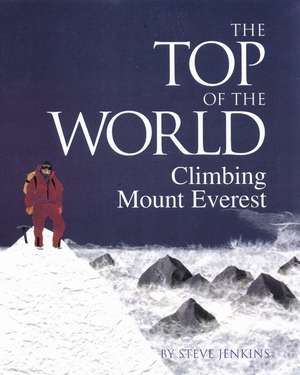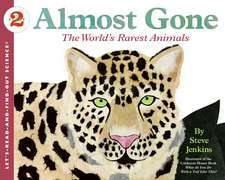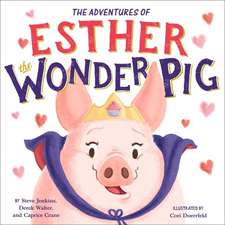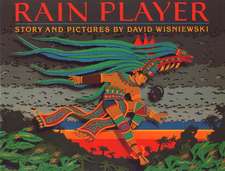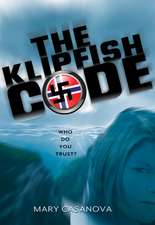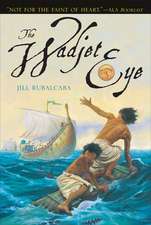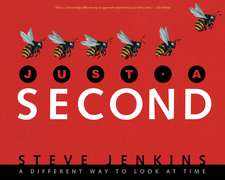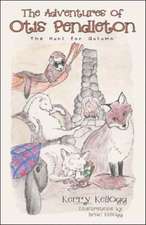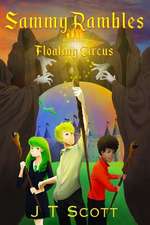The Top of the World: Climbing Mount Everest
Autor Steve Jenkinsen Limba Engleză Paperback – 28 apr 2002 – vârsta până la 7 ani
Take a trip to the highest peak in the whole world! Travel along this one-of-a-kind adventure and learn what it takes to successfully reach the top of this daring mountain. From sidebars filled with fascinating facts like why climbers need oxygen and how to protect against avalanches and frostbite to a list of all of the essentials that a climber needs on their thrilling journey, this informative text has it all. With riveting cut-paper collage illustrations, Steve Jenkins captures the majesty of one of the most extreme physical challenges and gives readers a bird’s-eye view of what it’s like to stand on top of the world.
Preț: 54.21 lei
Nou
Puncte Express: 81
Preț estimativ în valută:
10.38€ • 11.27$ • 8.72£
10.38€ • 11.27$ • 8.72£
Carte disponibilă
Livrare economică 31 martie-14 aprilie
Livrare express 14-20 martie pentru 29.21 lei
Preluare comenzi: 021 569.72.76
Specificații
ISBN-13: 9780618196760
ISBN-10: 0618196765
Pagini: 32
Ilustrații: Full-color illustrations
Dimensiuni: 216 x 279 x 3 mm
Greutate: 0.15 kg
Ediția:Reprint
Editura: HarperCollins Publishers
Colecția Clarion Books
Locul publicării:Italy
ISBN-10: 0618196765
Pagini: 32
Ilustrații: Full-color illustrations
Dimensiuni: 216 x 279 x 3 mm
Greutate: 0.15 kg
Ediția:Reprint
Editura: HarperCollins Publishers
Colecția Clarion Books
Locul publicării:Italy
Recenzii
The author-artist who gave us Biggest, Strongest, Fastest (1995) and What Do You Do When Something Wants to Eat You (1997) turns his attention to a slightly older audience in a picture book that takes readers on an armchair tour up the tallest peak on Earth. In preparation for the trek, Jenkins presents some background on Everest (including a brief comment on the ecological nightmare tourism has caused) and on some of the people who have scaled it. There's also a double-page spread devoted to climbing equipment. Then it's up to the top, complete with descriptions of some of the things climbers may see en route and some insight into how the cold and altitude will affect their bodies. Jenkins' papercut illustrations are extraordinary--feathery light to catch the effect of fog radiating off the mountains, mottled and striated to replicate rocky plateaus, pebbled to look like ice flowers.
Booklist, ALA
Mount Everest may be imposing, but Steve Jenkins takes its measure in a strikingly executed picture book. The cut-paper collage illustrations manage to show the grandeur of the world's tallest mountain with an immediacy that few photographs can. Using textured paper and only a little bit of airbrushing, Jenkins succeeds in the difficult task of creating realistic paper collages. The book follows a logical sequence, beginning with the statistics (where it is, how tall, how it was formed, how to get there, who climbed it first) and continuing with a virtual climbing experience for the reader: "It takes a lot of special gear to climb Mount Everest. Here is some of the equipment you'll need"-a spread displaying a delicious array of impressive rig. By the time we have reached the summit on the last spread, we have gained an understanding of the thrills as well as the immense hardships involved in this climb. Jenkins doesn't avoid details of frostbite and lost fingers, or even the visible litter of used oxygen canisters and frozen bodies of climbers who succumbed to the altitude and had to be left on the mountain. On nearly every spread there is an inset or sidebar providing additional infor-mation about glaciers and avalanches, the culture of the Sherpas, why climbers need oxygen, and other facts that are of interest but would break the forward motion of the main story. Exceptional design handles these bits of text remarkably well: the insets are clearly separate from the central spread, using a different background color and smaller type, while the torn paper edges of each sidebar allow it to become integrated into the spread. The subject matter-danger and heroism in a vast, breathtakingly beautiful setting-is inherently suited to a large, colorful picture book; the deft execution of the illustrations brings the whole package to a higher level. One of the pitfalls of using cut paper for realistic illustrations is the disappointing lack of realism in close-ups of faces, which require fine gradations of shading and color. The subject allows Jenkins to avoid this, since the climbers are most often seen completely covered up with scarves, hats, and sungoggles. Another potential difficulty can be depicting vapor and cloud realistically, but Jenkins makes full use of thin, wispy papers and deckle edges to create puffy clouds and blowing snow plumes. The book ends with illustrated back matter: a chart of the tallest summits on each continent, a list of Mount Everest facts and records, a few websites, and a bibliography. From start to finish, Jenkins has created a breathtaking tour-de-force.
Horn Book
"A breathtaking picture-book account of a climb to the top of Mount Everest. Jenkins (Hottest, Coldest, Highest, Deepest, 1998, etc.) documents each step of the way with vivid crushed-paper and cut-paper collages that will rivet viewers. He begins with a world map that shows the Himalayas, recounts efforts to measure the peaks, describes early expeditions, and includes the successful climbs of Sir Edmund Hillary and Tenzing Nor —
Booklist, ALA
Mount Everest may be imposing, but Steve Jenkins takes its measure in a strikingly executed picture book. The cut-paper collage illustrations manage to show the grandeur of the world's tallest mountain with an immediacy that few photographs can. Using textured paper and only a little bit of airbrushing, Jenkins succeeds in the difficult task of creating realistic paper collages. The book follows a logical sequence, beginning with the statistics (where it is, how tall, how it was formed, how to get there, who climbed it first) and continuing with a virtual climbing experience for the reader: "It takes a lot of special gear to climb Mount Everest. Here is some of the equipment you'll need"-a spread displaying a delicious array of impressive rig. By the time we have reached the summit on the last spread, we have gained an understanding of the thrills as well as the immense hardships involved in this climb. Jenkins doesn't avoid details of frostbite and lost fingers, or even the visible litter of used oxygen canisters and frozen bodies of climbers who succumbed to the altitude and had to be left on the mountain. On nearly every spread there is an inset or sidebar providing additional infor-mation about glaciers and avalanches, the culture of the Sherpas, why climbers need oxygen, and other facts that are of interest but would break the forward motion of the main story. Exceptional design handles these bits of text remarkably well: the insets are clearly separate from the central spread, using a different background color and smaller type, while the torn paper edges of each sidebar allow it to become integrated into the spread. The subject matter-danger and heroism in a vast, breathtakingly beautiful setting-is inherently suited to a large, colorful picture book; the deft execution of the illustrations brings the whole package to a higher level. One of the pitfalls of using cut paper for realistic illustrations is the disappointing lack of realism in close-ups of faces, which require fine gradations of shading and color. The subject allows Jenkins to avoid this, since the climbers are most often seen completely covered up with scarves, hats, and sungoggles. Another potential difficulty can be depicting vapor and cloud realistically, but Jenkins makes full use of thin, wispy papers and deckle edges to create puffy clouds and blowing snow plumes. The book ends with illustrated back matter: a chart of the tallest summits on each continent, a list of Mount Everest facts and records, a few websites, and a bibliography. From start to finish, Jenkins has created a breathtaking tour-de-force.
Horn Book
"A breathtaking picture-book account of a climb to the top of Mount Everest. Jenkins (Hottest, Coldest, Highest, Deepest, 1998, etc.) documents each step of the way with vivid crushed-paper and cut-paper collages that will rivet viewers. He begins with a world map that shows the Himalayas, recounts efforts to measure the peaks, describes early expeditions, and includes the successful climbs of Sir Edmund Hillary and Tenzing Nor —
